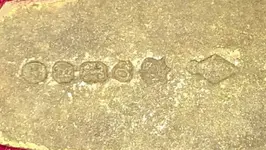They look like pseudo hallmarks to me, indicating a material other than silver. Definitely British though, the marking at far right seems to be a British registry mark, the equivalent to a design patent. That places the registration -- not necessarily the manufacture date -- between 1842-1883.
Mark Z
They are in fact pseudo-hallmarks.
They are in this case, indicative of plate (or more likely what is called, "nickle silver", which isn't silver at all).
This piece is likely not silver.
However, pseudo-hallmarks do appear on a large percentage of U.S. Coin Silver pieces (approximately 90% silver). Most pseudo-hallmarked coin silver pieces were manufactured in Upstate NY between 1850 and 1875. (although some pseudo-hallmarked pieces appear as early as 1820 or so). The Upstate NY sources were often sold wholesale to other retailers (typically jewelers and watchmakers) who sold them direct to customers, and stamped them with an additional mark, which was typically the seller's name.
Pseudo-hallmarked coin silver pieces usually have only 3 pseudo-hallmarks (similar to the trio of marks that typically appear on English silver, which is the look that coin silver pseudo-hallmarks were trying to mimic).
Pieces with four or five or more pseudo-hallmarks (like the piece in the original post) are almost always plate, or base metal (typically nickle silver, which has no actual silver content)
All of this text describes generally, the use of pseudo-hallmarks. There are examples of silver which do not conform to these general descriptions.




